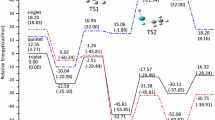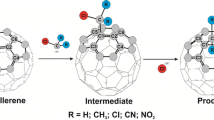Abstract
The mechanism of the cycloaddition reaction CH3M≡MCH3 (M=C, Si, Ge) with C2H4 has been studied at the CCSD(T)/6-311++G(d,p)//MP2/6-311++G(d,p) level. Vibrational analysis and intrinsic reaction coordinate (IRC), calculated at the same level, have been applied to validate the connection of the stationary points. The breakage and formation of the chemical bonds of the titled reactions are discussed by the topological analysis of electron density. The calculated results show that, of the three titled reactions, the CH3Si≡SiCH3+C2H4 reaction has the highest reaction activity because it has the lowest energy barriers and the products with the lowest energy. The CH3C≡CCH3+C2H4 reaction occurs only with difficulty since it has the highest energy barriers. The reaction mechanisms of the title reactions are similar. A three-membered-ring is initially formed, and then it changed to a four-membered-ring structure. This means that these reactions involve a [2+1] cycloaddition as the initial step, instead of a direct [2+2] cycloaddition.



Similar content being viewed by others
References
Power PP (2007) Organmetallics 26:4362–4372
Luke BT, Peple JA, Krogh-Jespersen MB, Apeloig Y, Karni M, Chandrasekhar J, Schleyer PVR (1986) J Am Chem Soc 108:270–284
Koseki S, Gordon MS (1988) J Phys Chem 92:364–367
Golegrove BT, Schaefer HF III (1991) J Am Chem Soc 113:1557–1561
Kobayashi K, Nagase S (1997) Organometallic 16:2489–2491
Nagase S, Kobayashi K, Tagagi N (2000) J Organmet Chem 611:254–258
Karni M, Apeloig Y (2002) Silicon Chem 1:61–66
Pignedoli CA, Curioni A, Andreoni W (2005) Chem Phys Chem 6:1795–1799
Lein M, Krapp A, Frenking G (2005) J Am Chem Soc 127:6290–6299
Frenking G, Krapp A, Nagase S, Takagi N, Sekiguchi A (2006) Chem Phys Chem 7:799–800
Pignedoli CA, Curioni A, Andreoni W (2006) Chem Phys Chem 7:801–802
Jung Y, Brynda M, Power PP, Head-Gordon M (2006) J Am Chem Soc 128:7185–7192
Sekiguchi A, Zigler SS, West R, Michl J (1986) J Am Chem Soc 108:4241–4242
Cordonnier M, Bogey M, Demuynck C, Destombes J-L (1982) J Chem Phys 97:7984–7989
Bogey M, Bolvin H, Demuynck C, Destombes J-L (1991) Phys Rev Lett 66:413–416
Karni M, Apeloig Y, Schroder D, Zummack W, Rabezanna R, Schwarz H (1999) Angew Chem Int Ed 38:332–335
Pietschnig R, West R, Powell DR (2000) Organometallics 19:2724–2729
Power PP (1999) Chem Rev 99:3463–3503
Pu L, Twamley B, Power PP (2000) J Am Chem Soc 122:3524–3525
Phillips AD, Wright RJ, Olmstead MM, Power PP (2002) J Am Chem Soc 124:5930–5931
Pu L, Phillips AD, Richards AF, Stender M, Simons RS, Olmstead MM, Power PP (2003) J Am Chem Soc 125:11626–11636
Sekiguchi A, Kinjo R, Ichinohe M (2004) Science 305:1755–1757
Sugiyama Y, Sasamori T, Hosoi Y, Furukawa Y, Takagi N, Nagase S, Tokitoh N (2006) J Am Chem Soc 128:1023–1031
Fischer RC, Pu L, Fettinger JC, Brynda MA, Power PP (2006) J Am Chem Soc 128:11366–11367
Wiberg N, Vasisht SK, Fischer G, Mayer P (2004) Z Anorg Allg Chem 630:1823–1828
Stender M, Phillips AD, Wright RJ, Power PP (2002) Angew Chem Int Ed 41:1785–1787
Power PP (2010) Nature 463:171–177
Kinjo R, Ichinohe M, Sekiguchi A, Takagi N, Sumimoto M, Nagase S (2007) J Am Chem Soc 129:7766–7767
Cui C, Olmstead MM, Power PP (2004) J Am Chem Soc 126:5062–5063
Cui C, Brynda M, Olmstead MM, Power PP (2004) J Am Chem Soc 126:6510–6511
Glowacki DR, Marsden SP, Pilling MJ (2009) J Am Chem Soc 131:13896–13897
Kına A, Piecuch P (2006) J Phys Chem A 110:367–378
Head-Gordon M, Pople JA, Frisch MJ (1988) Chem Phys Lett 153:503–506
Scuseria GE, Schaefer HF III (1989) J Chem Phys 90:3700–3703
Ishida G, Morokuma K, Komornicki A (1977) J Chem Phys 66:2153–2156
Frisch MJ, Trucks GW, Schlegel HB et al (2004) GAUSSIAN 03, Revision D. 02. Gaussian, Inc, Wallingford
Bader RFW (1990) Atoms in molecules: a quantum theory. Clarendon, Oxford
Popelier P (2000) Atoms in molecules-an introduction. UMIST Manchester
Biegler-könig F, Schonbohm J (2000) AIM 2000 program package, ver. 2.0. University of Applied Science, Bielefeld
Alikhani ME (1997) Chem Phys Lett 277:239–244
Bader RFW (1991) Chem Rev 91:893–928
Acknowledgments
Thanks for International Science Editing to edit this paper. This work was supported by the National Natural Science Foundation of China (Contract NO. 21102033, 21171047, 21073051), the Natural Science Foundation of Hebei Province (Contract NO. B2011205058), the Education Department Foundation of Hebei Province (NO. ZD2010126, ZH2012106).
Author information
Authors and Affiliations
Corresponding authors
Electronic supplementary material
Below is the link to the electronic supplementary material.
ESM 1
(DOC 6653 kb)
Rights and permissions
About this article
Cite this article
Huo, S., Li, X., Zeng, Y. et al. Reaction mechanism of CH3M≡MCH3 (M=C, Si, Ge) with C2H4: [2+1] or [2+2] cycloaddition?. J Mol Model 19, 3501–3506 (2013). https://doi.org/10.1007/s00894-013-1882-0
Received:
Accepted:
Published:
Issue Date:
DOI: https://doi.org/10.1007/s00894-013-1882-0




